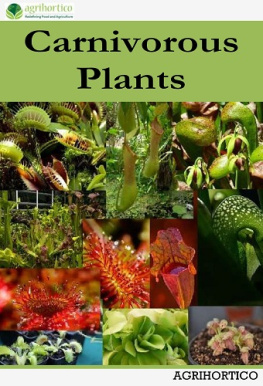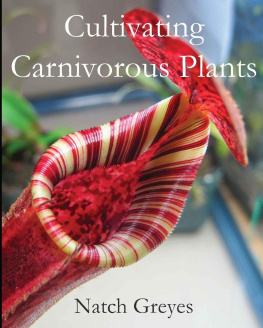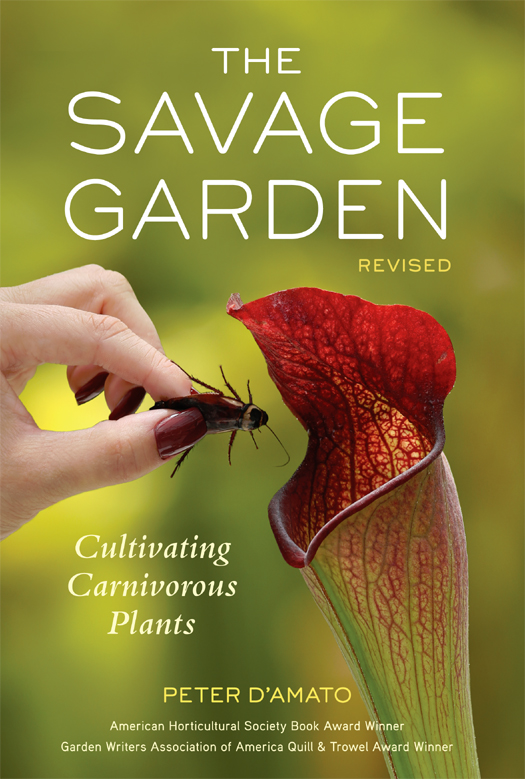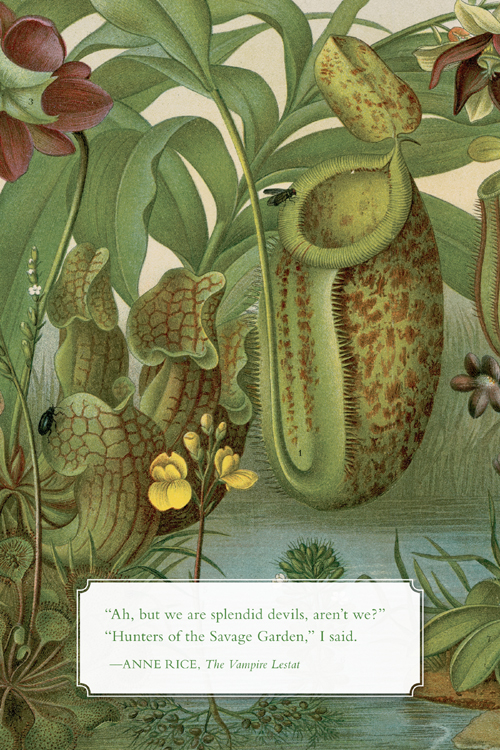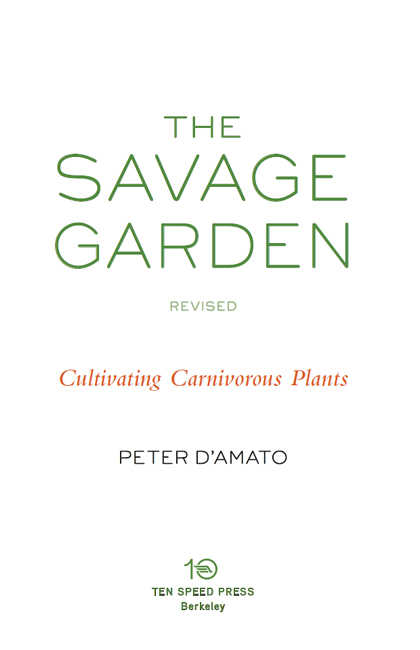Copyright 1998, 2013 by Peter D'Amato
All rights reserved. Published in the United States by Ten Speed Press, an imprint of the Crown Publishing Group, a division of Random House, Inc., New York.
www.crownpublishing.com
www.tenspeed.com
Ten Speed Press and the Ten Speed Press colophon are registered trademarks of Random House, Inc.
A previous edition of this work was published in the United States in paperback by Ten Speed Press, Berkeley, in 1998.
All photography and illustration in credits
Library of Congress Cataloging-in-Publication Data DAmato, Peter.
The savage garden / Peter DAmato. Rev.
p. cm.
1. Carnivorous plants. I. Title.
SB432.7.D35 2013
635.93375dc23
2012047904
eBook ISBN: 978-1-60774-411-5
Trade Paperback ISBN: 978-1-60774-410-8
photograph by Patrick Hollingsworth
v3.1
I dedicate this book to my biz partners,
Damon Collingsworth and Mickey Urdea, and
to our employees at California Carnivores,
Norma McFaddan, Liz Brown, Axel Bostrom,
and Tom Kahlall of us slaves of
flesh-eating plants.
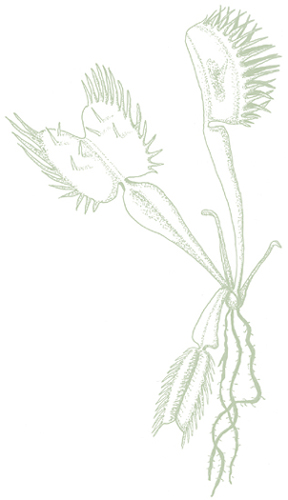
CONTENTS
PART ONE
THE BASICS OF CULTIVATION
PART TWO
WHERE TO GROW CARNIVOROUS PLANTS
PART THREE
THE PLANTS AND HOW TO GROW THEM
PREFACE
I find it ironic that this introduction to the revised edition of The Savage Garden is the final section of the book I am completing, only one week after returning from the 2012 International Carnivorous Plant Society (ICPS) conference hosted by the New England Carnivorous Plant Society. I had a wonderful time at the conference, and in a presentation I gave, I briefly told the audience some details of this new edition. The irony is that at the very first world conference of the ICPS, held at the Atlanta Botanical Garden in 1997, I gave a slide show preview of the first edition of the book. Little did I truly comprehend at the time the potential impact of the book. It won the American Horticultural Societys book award in 1999 and became a best seller in the genre, and only two weekends ago in New England I autographed dozens of copies for attendees of the conference. Nearly all of the books were well worn, well read, many with colorful bits of paper bookmarking sections of the book important to the readerwell, I was humbled and pleased.
The Savage Garden was not just a coffee table book of pretty pictures, but a resource that people actually read for the helpful information it contained. It was the type of book I wish had existed when I was a kid in the late 1960s, when carnivorous plants first took hold of my life, yet information on themespecially how to grow themwas sorely lacking.
There have been many ICPS conferences since 1997 all over the world, from Japan to Australia, from Europe to North America. The one this past month in New England was startling not only for the amazing show of fantastically beautiful carnivorous plants on display and for sale, but also for the delightful variety of people attending. Adults and kids, men and women, boys and girlsthings have certainly changed since I was a teenagerwhen you could count on one hand the serious growers of carnivorous plants in the United States. Since then, thousands of people all over the world have found the hobby an intoxicating experience. Carnivorous plants are educational, sometimes challenging, utterly and strangely beautiful, and a lot of fun to grow! Plus, unlike other plants they dont just sit there!

So how does this revision differ from the first edition? A lot has happened in fifteen years.
Most of the cultivation information has remained primarily intact, but I have tweaked and fine-tuned many details learned over the years. Much of this has come from customers of my nursery, California Carnivores, who have done things unimaginable a decade and a half ago. Other changes came from continual experiments at our nursery, resulting in adjustments to soil recipes, or discovering the cold and freeze tolerance of various subtropical plants. The results were often surprising.
Perhaps the greatest changes have occurred in the identification of many of the plants and the astounding numbers of new species discovered and brought into cultivation in the past fifteen years.
When I first wrote The Savage Garden , for example, most of the varieties of Sarracenia , the American pitcher plants, had nicknames only, such as red tube or coppertop or okee giant. All of these plants, and many new ones discovered and cultivated since, now have true names (see ).
The vast number of new species that have been discovered and identified is truly amazing. When I first wrote the book, there were five known species of South American sun pitchers ( Heliamphora ). Now, the count is approaching twenty-five! The butterworts ( Pinguicula ) have jumped from seventy species to more than one hundred. And when I first wrote the book there were around eighty species of tropical pitcher plants ( Nepenthes ) knownthe count is now approaching one hundred fiftywith many more expected to be discovered as modern-day enthusiasts climb the countless unexplored mountains from the Philippines to New Guinea. More carnivorous plants have been discovered in the last decade than at any time in the past.
I have also updated some technological advances, like the invention of polycarbonate greenhouse glazing, which is far superior to fiberglass and glass. Grow light technology has also improved greatly, with far superior artificial lights on the market. We have discovered a new fertilizer that doesnt kill live sphagnum moss, and many new insecticidessome completely naturalthat can control bothersome pests with no harm to plants or people.
I have also added the metric system to the revisiona tedious effort that nearly drove me insane. Please keep in mind these systems of measurements are rough and approximate!
I want to thank my business partner, Damon Collingsworth, for taking on the task of coordinating all the photographs for the book. He took dozens of new photos at our nursery and solicited many others from our friends both near and far. As just one example, the photography of plant autopsies, taken by California Carnivores volunteer Patrick Hollingsworth, is unsurpassed. And the astounding images lent to us by naturalists like Chien Lee, Fernando Rivadavia, Stewart McPherson, Barry Rice, and Andreas Fleischman are certainly compelling and hypnotic.

I must end this preface to a book on a topic that has brought so much joy to so many people around the world with a message of sadness and pain.
After the recent conference in New England, many of the attendees went on field trips to see carnivorous plants in the wild. They saw local bogs in New England as well as sites in New Jersey, North Carolina, and the Gulf Coast of southeastern North America, where more species of carnivorous plant genera exist than anywhere else in the world. The excitement of seeing several habitats in protected, pristine beauty was unfortunately overshadowed by one heartbreaking fact: these astounding forms of life are disappearing from our planet at a rate that is beyond alarming.


